
Bodega Bay is a shallow, rocky inlet of the Pacific Ocean on the coast of northern California in the United States. It is approximately 5 mi (8 km) across and is located approximately 40 mi (60 km) northwest of San Francisco and 20 mi (32 km) west of Santa Rosa. The bay straddles the boundary between Sonoma County to the north and Marin County to the south. The bay is a marine habitat used for navigation, recreation, and commercial and sport fishing.

Fort Ross, originally Fortress Ross, is a former Russian establishment on the west coast of North America in what is now Sonoma County, California. It was the hub of the southernmost Russian settlements in North America from 1812 to 1841. Notably, it was the first multi-ethnic community in northern California, with a combination of Native Californians, Native Alaskans, and Russians. It has been the subject of archaeological investigation and is a California Historical Landmark, a National Historic Landmark, and on the National Register of Historic Places. It is part of California's Fort Ross State Historic Park.

A California Historical Landmark (CHL) is a building, structure, site, or place in California that has been determined to have statewide historical landmark significance.
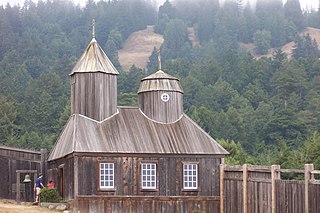
Fort Ross State Historic Park is a historical state park in Sonoma County, California, including the former Russian fur trading outpost of Fort Ross plus the adjacent coastline and native coast redwood forests extending inland. It is located on the northern California coast about 12 miles north of the town of Jenner and 22 miles north of Bodega Bay. Fort Ross, active from 1812 to 1842, was the southernmost settlement in the Russian colonization of the Americas. The 3,393-acre (1,373 ha) park was established in 1909. The site is a Sonoma County Historic Landmark.

The Allegheny County Courthouse in downtown Pittsburgh, Pennsylvania, is part of a complex designed by H. H. Richardson. The buildings are considered among the finest examples of the Romanesque Revival style for which Richardson is well known.
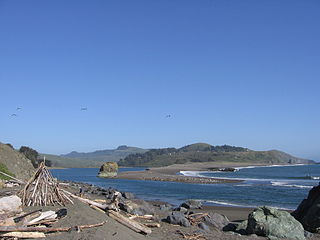
The Russian River is a southward-flowing river that drains 1,485 sq mi (3,850 km2) of Sonoma and Mendocino counties in Northern California. With an annual average discharge of approximately 1,600,000 acre feet (2.0 km3), it is the second-largest river flowing through the nine-county Greater San Francisco Bay Area, with a mainstem 115 mi (185 km) long.

Rancho Petaluma Adobe is a historic ranch house in Sonoma County, California. It was built from adobe bricks in 1836 by order of Mariano Guadalupe Vallejo. It was the largest privately owned adobe structure built in California and is the largest example of the Monterey Colonial style of architecture in the United States. A section of the former ranch has been preserved by the Petaluma Adobe State Historic Park and it is both a California Historic Landmark and a National Historic Landmark. The Rancho Petaluma Adobe State Historic Park is located on Adobe Road on the east side of the present-day town of Petaluma, California.

Jack London State Historic Park, also known as Jack London Home and Ranch, is a California State Historic Park near Glen Ellen, California, United States, situated on the eastern slope of Sonoma Mountain. It includes the ruins of a house burned a few months before Jack London and family were to move in, a cottage in which they had lived, another house built later, and the graves of Jack London and his wife. The property is both a California Historical Landmark and a National Historic Landmark.
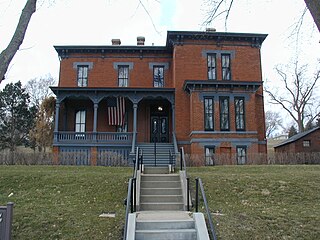
The General George Crook House Museum is located in Fort Omaha. The Fort is located in the Miller Park neighborhood of North Omaha, Nebraska, United States. The house was listed on the National Register of Historic Places in 1969, and is a contributing property to the Fort Omaha Historic District.

Castle Hill also known as the American Flag-Raising Site and now as the Baranof Castle State Historic Site, is a National Historic Landmark and state park in Sitka, Alaska. The hill, providing a commanding view over the city, is the historical site of Tlingit and Russian forts, and the location where Russian Alaska was formally handed over to the United States in 1867. It is also where the 49-star United States flag was first flown after Alaska became a state in 1959.

Salmon Creek is an 18.3-mile-long (29.5 km) stream in western Sonoma County, California that springs from coastal hills west of the town of Occidental and empties into the Pacific Ocean north of Bodega Head.
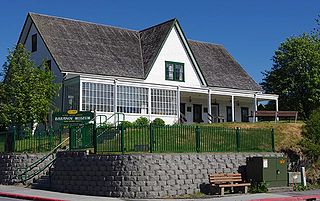
The Kodiak History Museum, until 2019 known as the Baranov Museum, is a history museum at 101 East Marine Way in Kodiak, Alaska. It is located in a National Historic Landmark building known as the Russian-American Magazin [sic] and the Erskine House, which also houses the office of the Kodiak Historical Society. Built c. 1810, the building is the oldest of four surviving building constructed by the Russians when Alaska was a Russian territory. The museum's collections and exhibits are focused on the history of the Kodiak Archipelago and the Aleutian Islands, with particular focus on the Russian and early American periods. The museum's current director is Sarah Harrington.
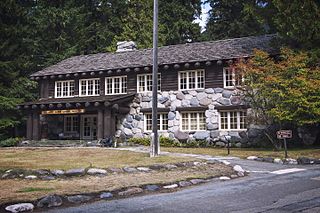
The Longmire Buildings in Mount Rainier National Park comprise the park's former administrative headquarters, and are among the most prominent examples of the National Park Service Rustic style in the national park system. They comprise the Longmire Community Building of 1927, the Administration Building of 1928, and the Longmire Service Station of 1929. Together, these structures were designated National Historic Landmarks on May 28, 1987. The administration and community buildings were designed by National Park Service staff under the direction of Thomas Chalmers Vint.

The Larkin House is a historic house at 464 Calle Principal in Monterey, California. Built in 1835 by Thomas O. Larkin, it is claimed to be the first two-story house in all of California, with a design combining Spanish Colonial building methods with New England architectural features to create the popular Monterey Colonial style of architecture. The Larkin House is both a National and a California Historical Landmark, and is a featured property of Monterey State Historic Park.

Condominium 1 was the first unit in the Sea Ranch development on the Pacific coast of Sonoma County, California. The complex was designed by Charles W. Moore, Donlyn Lyndon, William Turnbull, Jr. and Richard Whitaker of the MLTW partnership in 1963–1964, and was built by contractor Matthew Sylvia in 1965. The timber-framed structure overlooks the Pacific Ocean. It has been described as one of the most significant architectural designs of the 1960s in California, and has received numerous awards.

Wolf House was a 26-room mansion in Glen Ellen, California, built by novelist Jack London and his wife Charmian London. The house burned on August 22, 1913, shortly before the Londons were planning to move in. Stone ruins of the never-occupied home still stand, and are part of Jack London State Historic Park, which has been a National Historic Landmark since 1963.

The Sonoma Barracks is a two-story, wide-balconied, adobe building facing the central plaza of the City of Sonoma, California. It was built by order of Mariano Guadalupe Vallejo to house the Mexican soldiers that had been transferred from the Presidio of San Francisco in 1835. The Presidio Company and their commander, Vallejo, were also responsible for controlling the Native Americans living on the northern border of Mexican California.

The California Powder Works Bridge is a historic covered bridge in Santa Cruz, California. It is a Smith truss bridge, built across the San Lorenzo River in 1872 by the California Powder Works, an explosives manufacturer whose factory complex stood on the river banks. The bridge was designated a National Historic Landmark in 2015 as one of the best-preserved national examples of the Smith truss. It is owned and maintained by the Paradise Park Masonic Club, and is open to pedestrian and vehicular traffic, with a posted weight limit of 5 tons.

The Hinds Hotel is a historic building located in Freestone, California in the United States. Built in 1876, the Hinds Hotel is a former hotel, antique store and plant nursery. Today, it serves as a private commercial business and home. It is listed on the National Register of Historic Places and has been named a California Historic Landmark and a Sonoma County Historic Landmark.
The Salvador Vallejo Adobe is a historic building located in Sonoma, California in the United States. The building is a California Historic Landmark.





















